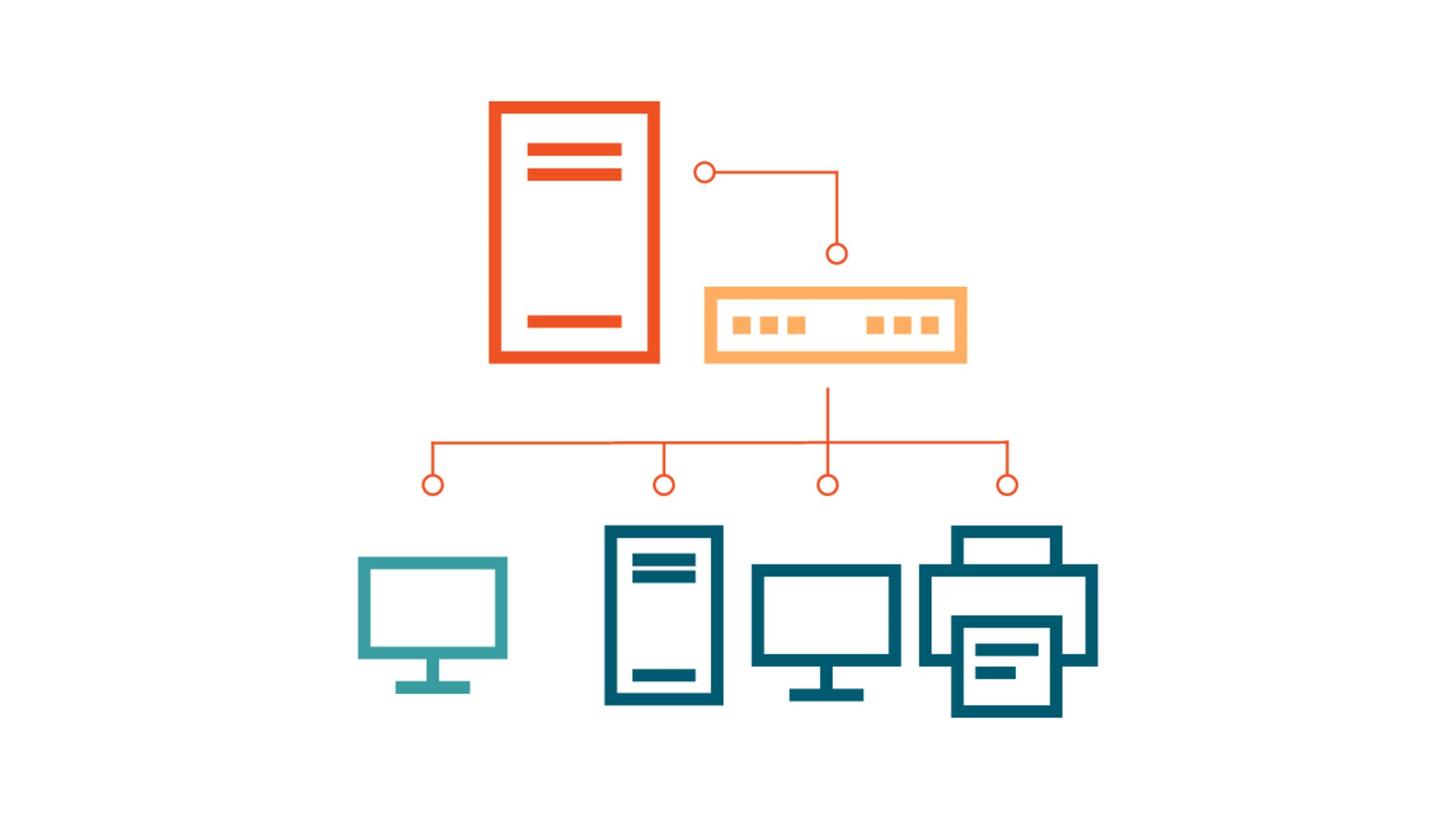Introduction
When we talk about computers in a networked environment, one important component that plays a crucial role is the Domain Controller. A Domain Controller acts as the central authority in a Windows domain, managing the authentication and authorization of user accounts and domain resources. But have you ever wondered how a workstation knows which Domain Controller to use?
In this article, we will explore the fascinating world of Domain Controllers and uncover the mechanisms through which workstations discover and connect to the appropriate Domain Controller.
A Domain Controller is a server that runs the Active Directory service, which is responsible for managing and authenticating users, computers, and other network resources within a Windows domain. It acts as the gatekeeper, controlling access to resources and ensuring that security policies are enforced.
Nowadays, networks can span multiple locations and consist of hundreds or even thousands of computers. In such complex environments, the efficient discovery of the appropriate Domain Controller becomes crucial for seamless network operations.
When a workstation boots up or a user logs in, it needs to find and connect to a Domain Controller to validate user credentials, retrieve group policies, and access domain resources. The process of discovering the appropriate Domain Controller involves several mechanisms, including DNS-based discovery, SRV records, NetBIOS name resolution, Active Directory Sites and Services, and Active Directory Locator DNS records.
Understanding how a workstation discovers a Domain Controller is essential for network administrators and IT professionals. By gaining insight into these mechanisms, they can optimize their network configurations, ensure high availability, and streamline authentication processes.
In the following sections, we will delve into each of these discovery mechanisms and discuss best practices for configuring Domain Controllers to ensure efficient and seamless network operations.
What is a Domain Controller?
A Domain Controller (DC) is a crucial component of the Windows Server operating system. It plays a vital role in managing and controlling a Windows domain network. Essentially, a Domain Controller acts as the central authority that authenticates and authorizes users, computers, and other network resources within the domain.
When a network is set up with a domain, all user accounts, group policies, security information, and other network-related data are stored within the Active Directory service, which is hosted on one or more Domain Controllers. This centralized approach allows for streamlined administration and simplified management of users and resources.
The responsibilities of a Domain Controller are manifold. Here are some key functions performed by a Domain Controller:
1. Authentication: The primary duty of a Domain Controller is to authenticate user accounts. When a user attempts to log in to a domain-joined workstation, the workstation sends the login credentials to the Domain Controller. The Domain Controller verifies the username and password and grants access to the system upon successful authentication.
2. Authorization: A Domain Controller also manages authorization, determining what actions and resources a user can access based on their group memberships and security policies defined within the Active Directory. This ensures that only authorized individuals can perform specific tasks or access restricted information within the network.
3. Group Policy Management: Domain Controllers are responsible for enforcing and distributing Group Policies throughout the network. Group Policies allow administrators to configure and control various aspects of the workstation and user settings, including security configurations, software installations, and desktop customizations. The Domain Controller ensures that these policies are effectively applied to the appropriate users and computers.
4. Replication: In multi-domain or multi-site environments, where multiple Domain Controllers are deployed, the Domain Controllers coordinate and replicate the Active Directory databases. This ensures that the data remains consistent across all Domain Controllers and provides fault tolerance and high availability.
5. Name Resolution: Domain Controllers also play a role in resolving network resources’ names to their corresponding IP addresses. By having DNS services integrated with Active Directory, the Domain Controller handles DNS queries, allowing workstations to locate resources efficiently.
In summary, a Domain Controller is the backbone of a Windows domain network. It authenticates users, authorizes access to resources, manages group policies, replicates Active Directory data, and helps with name resolution. Without Domain Controllers, the smooth functioning and management of a network would be significantly compromised.
Importance of Domain Controllers in a Network
Domain Controllers play a pivotal role in the efficient functioning of a network. They offer numerous benefits and are integral to the smooth operation of a Windows domain environment. Let’s explore the importance of Domain Controllers and why they are indispensable in network infrastructure.
1. Centralized Authentication and Authorization: Domain Controllers serve as a centralized authority for user authentication and authorization. They verify user credentials, ensuring that only authorized individuals can access network resources. This centralized approach enhances security and simplifies management, as administrators can easily define and enforce security policies across the network from a single point of control.
2. Single Sign-On (SSO) Experience: With Domain Controllers, users can enjoy the convenience of single sign-on. Once authenticated by a Domain Controller, users can access various network resources without repeatedly entering their credentials. This streamlined user experience enhances productivity and eliminates the need for multiple logins.
3. Group Policy Management: Domain Controllers enable the efficient management and deployment of Group Policies. These policies allow administrators to configure workstation settings, control software installations, and enforce security policies. With consistent application of Group Policies across the network, administrators can maintain standardization and ensure compliance with organizational requirements.
4. Centralized User and Resource Management: By hosting the Active Directory service, Domain Controllers provide a centralized repository for user accounts, computer accounts, and other network-related data. This centralized management simplifies user and resource administration, allowing administrators to efficiently add, modify, or remove user accounts, set permissions, and allocate resources.
5. High Availability and Fault Tolerance: In larger networks, multiple Domain Controllers are deployed to ensure high availability and fault tolerance. If one Domain Controller becomes unavailable, others can seamlessly handle authentication and authorization requests. Replication of Active Directory data between Domain Controllers ensures data consistency and redundancy.
6. Active Directory Integration: Domain Controllers integrate with the Active Directory service, which provides additional features such as efficient name resolution through DNS integration. This integration streamlines resource discovery and enhances network performance.
7. Scalability: Domain Controllers allow for network scalability by accommodating a growing number of users, workstations, and network resources. As the organization expands, additional Domain Controllers can be deployed to handle the increased demands, ensuring optimal performance and responsiveness.
In summary, Domain Controllers are essential components in network infrastructure. They provide centralized authentication and authorization, enable single sign-on experiences, facilitate group policy management, offer centralized user and resource management, ensure high availability and fault tolerance, integrate with Active Directory, and support network scalability. Without Domain Controllers, the management, security, and functionality of a network would be significantly compromised.
How Workstations Discover Domain Controllers
When a workstation needs to connect to a Domain Controller in a Windows domain environment, it goes through a process of discovering the appropriate Domain Controller. This discovery process involves several mechanisms and protocols to ensure efficient and reliable connections. Let’s explore how workstations discover Domain Controllers.
1. DNS Based Discovery: Workstations initially use DNS (Domain Name System) to locate a Domain Controller. They send a query to the DNS server, looking for the SRV (Service Location) records specific to Domain Controllers. These SRV records contain information about the Domain Controllers available for the domain. The client then selects a suitable Domain Controller based on the criteria such as availability, proximity, and site-specific preferences.
2. SRV Records: The SRV records in DNS are crucial for Domain Controller discovery. These records provide information such as the server’s name, port number, priority, and weightage. Workstations use this information to identify the available Domain Controllers and establish a connection.
3. NetBIOS Name Resolution: In older Windows environments or in situations where DNS-based discovery is not available, workstations can use NetBIOS name resolution to find a Domain Controller. They send a NetBIOS broadcast or query the WINS (Windows Internet Naming Service) server to resolve the NetBIOS name of the desired Domain Controller.
4. Active Directory Sites and Services: Active Directory Sites and Services play a vital role in Domain Controller discovery, especially in a multi-site environment. Sites are logical groupings of subnets and help in defining the physical network topology. Workstations use site information provided by Active Directory Sites and Services to identify Domain Controllers within their respective sites. This ensures that workstations connect to the nearest Domain Controller, reducing network latency and improving performance.
5. Active Directory Locator DNS Records: Active Directory Locator DNS records provide information about the availability and location of Domain Controllers within a domain. Workstations can query these records to obtain the required data for Domain Controller discovery.
By employing a combination of these discovery mechanisms, workstations can efficiently locate and establish connections with the appropriate Domain Controllers. This ensures optimal network performance, user authentication, and access to domain resources.
Network administrators can fine-tune the Domain Controller discovery process by configuring DNS settings, prioritizing preferred Domain Controllers, specifying site configurations within Active Directory Sites and Services, and ensuring the availability and reliability of DNS and Active Directory services.
Understanding how workstations discover Domain Controllers is crucial for network administrators and IT professionals. It allows them to optimize network configurations, improve authentication processes, and enhance overall network performance and reliability.
DNS Based Discovery
DNS (Domain Name System) based discovery is one of the primary methods used by workstations to locate a Domain Controller in a Windows domain environment. DNS allows for the translation of domain names into their corresponding IP addresses, which is essential for network communication.
When a workstation needs to find a Domain Controller, it sends a query to the DNS server requesting the SRV (Service Location) records specific to Domain Controllers. These SRV records contain information about the Domain Controllers available for the domain, including their names, IP addresses, ports, and other relevant details.
The process of DNS based discovery involves the following steps:
1. Workstation Sends DNS Query: The workstation sends a DNS query to the designated DNS server, typically the DNS server configured on the workstation’s network settings. The query is requesting the SRV records associated with Domain Controllers.
2. DNS Server Responds with SRV Records: The DNS server receives the query and responds with the SRV records containing the Domain Controller information. These records are stored in the _ldap._tcp.dc._msdcs.< domain name > namespace.
3. Selection of Suitable Domain Controller: The workstation examines the SRV records and selects a suitable Domain Controller based on factors such as availability, proximity, and site-specific preferences. The priority and weightage specified in the SRV records can influence this selection.
4. Establishing Connection with the Domain Controller: Once the suitable Domain Controller is selected, the workstation connects to it using its IP address and other relevant details obtained from the SRV records. This connection allows the workstation to authenticate users, retrieve group policies, and access domain resources.
DNS based discovery offers several advantages. It leverages the existing DNS infrastructure in the network, simplifying the connectivity process. Additionally, it allows for load balancing and fault tolerance, as multiple SRV records can be returned, enabling workstations to connect to different Domain Controllers.
To ensure successful DNS based discovery, network administrators need to maintain accurate SRV records in the DNS server and regularly update them as the network configuration changes. They should also ensure that DNS servers are highly available, responsive, and properly configured.
It is worth noting that DNS based discovery requires properly configured DNS settings on workstations and Domain Controllers. It is essential to verify that DNS queries are directed to the correct DNS server and that DNS resolution is functioning correctly.
In summary, DNS based discovery plays a key role in enabling workstations to locate and connect to the appropriate Domain Controllers. By leveraging SRV records and DNS infrastructure, it provides an efficient and reliable mechanism for workstation-Domain Controller communication in a Windows domain environment.
SRV Records
SRV (Service Location) records are crucial components of DNS (Domain Name System) that facilitate the discovery and connection of Domain Controllers by workstations in a Windows domain environment. SRV records provide detailed information about the available Domain Controllers, including their names, IP addresses, port numbers, and priority levels.
Here is how SRV records contribute to the discovery process:
1. SRV Record Structure: An SRV record consists of various fields that hold important information. The fields include:
– Service: This field specifies the service associated with the record, in this case, “_ldap”.
– Protocol: This field specifies the protocol used for communication, typically “_tcp”.
– Name: The name field specifies the domain name, using the format “_ldap._tcp.dc._msdcs.< domain name >“.
– Priority and Weightage: These fields indicate the priority level and weightage of the Domain Controllers. Lower values signify higher priority, and weightage determines the preference among Domain Controllers with the same priority.
– Port: This field specifies the port number on which the service is available, with LDAP typically using port 389.
– Target: The target field contains the hostname of the Domain Controller.
2. Workstation Querying SRV Records: When a workstation needs to find a Domain Controller, it sends a DNS query requesting the SRV records specific to Domain Controllers. The query typically follows the format “_ldap._tcp.dc._msdcs.< domain name >“, indicating the desired SRV records for the LDAP service.
3. DNS Server Responds with SRV Records: The DNS server receives the query and responds with the requested SRV records. The response contains multiple SRV records, each corresponding to a different Domain Controller. These records provide the necessary information for workstations to establish connections with the Domain Controllers.
4. Selection of Suitable Domain Controller: The workstation analyzes the SRV records received from the DNS server. It considers factors such as priority, weightage, availability, and site-specific preferences to determine the most suitable Domain Controller to connect to.
5. Connecting to the Domain Controller: With the selected Domain Controller determined, the workstation uses the IP address and additional details obtained from the SRV records to establish a connection. This connection allows the workstation to authenticate users, retrieve group policies, and access domain resources.
SRV records are critical for Domain Controller discovery, as they provide workstations with the necessary information to connect to the appropriate Domain Controllers. They play a fundamental role in load balancing and fault tolerance, as the priority and weightage fields influence the selection of Domain Controllers.
To ensure effective SRV record usage, network administrators should regularly update and maintain accurate SRV records in the DNS server. Properly configuring priority and weightage values will ensure the appropriate load distribution among Domain Controllers. Furthermore, administrators must monitor DNS server availability and responsiveness to ensure successful SRV record retrieval.
In summary, SRV records are indispensable for the effective discovery and connection of Domain Controllers by workstations. By providing detailed information about available Domain Controllers, SRV records streamline the process of connecting to the appropriate Domain Controller in a Windows domain environment.
NetBIOS Name Resolution
In certain scenarios, workstations may utilize NetBIOS name resolution to discover and connect to a Domain Controller in a Windows domain environment. NetBIOS (Network Basic Input/Output System) is an older networking protocol that allows communication between computers on a local network.
The NetBIOS name resolution process involves the following steps:
1. Workstation Sends NetBIOS Broadcast: When a workstation needs to find a Domain Controller, it sends a NetBIOS broadcast on the local network segment. This broadcast is a request for the NetBIOS name associated with the Domain Controller. The NetBIOS name typically follows the format “DOMAINNAME< 1B >“, where DOMAINNAME represents the name of the domain.
2. WINS Server Query (Optional): If a WINS (Windows Internet Name Service) server is available in the network, the workstation can send a query to it rather than using a broadcast. The WINS server maintains a database mapping NetBIOS names to IP addresses.
3. Response from Domain Controller: The Domain Controller recognizes the NetBIOS broadcast or query and responds with its NetBIOS name and IP address. The response is sent directly to the requesting workstation.
4. Establishing Connection with the Domain Controller: The workstation uses the NetBIOS name and IP address obtained from the Domain Controller to establish a connection. This connection allows the workstation to authenticate users, retrieve group policies, and access domain resources.
NetBIOS name resolution can be useful in legacy network environments or situations where DNS-based discovery is not available or not functioning correctly. However, its usage is gradually decreasing with the widespread adoption of DNS and the Active Directory service.
To enable successful NetBIOS name resolution, the following considerations must be taken into account:
– NetBIOS over TCP/IP: NetBIOS name resolution relies on the NetBIOS protocol, which typically operates over TCP/IP. Hence, the TCP/IP protocol must be properly configured on the workstations and Domain Controllers for NetBIOS resolution to take place.
– Availability of WINS Server: If a WINS server is utilized for NetBIOS name resolution, it needs to be properly configured and maintained. The WINS server should have accurate mappings of NetBIOS names to IP addresses, ensuring reliable and efficient name resolution.
– Broadcast Limitations: NetBIOS broadcast traffic is limited to the local network segment. Workstations and Domain Controllers must be within the same broadcast domain for NetBIOS name resolution to work effectively.
While NetBIOS name resolution is not as commonly used as DNS based discovery, it remains a viable option in certain network scenarios. Network administrators should ensure that NetBIOS settings are correctly configured to facilitate successful NetBIOS name resolution when needed.
In summary, NetBIOS name resolution provides an alternative method for workstations to discover and connect to a Domain Controller. While less prevalent than DNS based discovery, it can be useful in legacy environments or when DNS is not available. Understanding NetBIOS name resolution helps network administrators troubleshoot connectivity issues and ensure efficient communication within a Windows domain environment.
Active Directory Sites and Services
In larger network environments, where multiple locations or sites are involved, Active Directory Sites and Services provides a mechanism for optimizing Domain Controller discovery. Active Directory Sites and Services allows administrators to logically group network resources based on physical network topology, creating site objects that represent different locations.
Here is how Active Directory Sites and Services enhances Domain Controller discovery:
1. Site Objects: Site objects are created within Active Directory Sites and Services to represent physical locations or sites in the network. Each site object is associated with one or more subnets, which are IP address ranges assigned to a specific location.
2. Site Links: Site links define the connectivity between different sites in the network. They specify the available network connections and the associated costs (link speed, bandwidth, etc.) between sites. Site links mirror the actual network infrastructure.
3. Site-Subnet Mapping: Subnets are mapped to their respective site objects within Active Directory Sites and Services. This mapping associates the IP address ranges assigned to a location with the corresponding site object.
4. Site Preference Configuration: Administrators can assign preferred Domain Controllers to specific sites, known as “preferred bridgehead servers.” This configuration ensures that workstations within a site prioritize connecting to the preferred Domain Controller, improving response time and network performance.
5. Active Directory Replication Optimization: Active Directory Sites and Services also influence the replication of Active Directory data between Domain Controllers in different sites. Replication is optimized to occur within the site boundary, reducing unnecessary traffic across wide area network (WAN) connections.
When a workstation needs to locate a Domain Controller, it queries Active Directory Sites and Services, utilizing the site information to determine the most appropriate Domain Controller based on network topology and distance. Workstations aim to connect to a Domain Controller within the same site or a nearby site to minimize latency and improve performance.
Active Directory Sites and Services significantly improves Domain Controller discovery in multi-site environments. It ensures that workstations are directed to Domain Controllers within their respective sites, reducing network congestion, and accommodating distributed network infrastructure.
To optimize Active Directory Sites and Services, administrators should consider the following:
– Proper Site Configuration: Ensure that site objects, subnets, and site links accurately reflect the network’s physical layout. Regularly review and update the site configuration as the network evolves or new sites are added.
– Preferred Bridgehead Servers: Assign preferred bridgehead servers to sites based on factors such as network bandwidth and server capabilities. Regularly evaluate and update these assignments to ensure optimal performance and responsiveness.
– Monitoring and Troubleshooting: Monitor Active Directory replication, site-to-site connectivity, and overall network health using appropriate tools. Deploying monitoring solutions helps identify and resolve issues that may affect Domain Controller discovery and connectivity.
By effectively utilizing Active Directory Sites and Services, network administrators can streamline Domain Controller discovery, enhance network performance, and ensure efficient network connectivity across distributed sites.
Active Directory Locator DNS Records
In a Windows domain environment, Active Directory Locator DNS records play a vital role in assisting workstations in discovering the appropriate Domain Controllers. These records provide crucial information about the availability and location of Domain Controllers within the domain.
Here is how Active Directory Locator DNS records contribute to the Domain Controller discovery process:
1. Types of Active Directory Locator DNS Records: There are several types of DNS records that serve as Active Directory Locator records, including:
– _ldap._tcp.dc._msdcs. records: These SRV (Service Location) records contain information about the available Domain Controllers, their names, IP addresses, ports, and other details.
– Domain Controller A Records: These records map the fully qualified domain name (FQDN) of the Domain Controllers to their IP addresses.
– Domain Controller CNAME Records: CNAME (Canonical Name) records provide an alias for the Domain Controller hostname.
2. Publishing Active Directory Locator DNS Records: When a domain is configured, the Domain Controllers automatically publish their information as Active Directory Locator DNS records in the DNS server associated with the domain. This ensures that the records are readily available for workstations during the discovery process.
3. Workstation Querying Active Directory Locator DNS Records: When a workstation needs to find a Domain Controller, it queries the DNS server for the Active Directory Locator DNS records. The workstation typically searches for SRV records in the _ldap._tcp.dc._msdcs.< domain name > namespace and A/CNAME records for the Domain Controllers.
4. Response with Active Directory Locator DNS Records: The DNS server responds to the workstation’s query with the requested Active Directory Locator DNS records. The response typically includes several SRV records and A/CNAME records corresponding to the available Domain Controllers.
5. Using Active Directory Locator DNS Records: The workstation analyzes the Active Directory Locator DNS records to select an appropriate Domain Controller for establishing a connection. The records provide necessary information such as IP addresses, names, and other details required to initiate the connection.
Active Directory Locator DNS records provide an additional layer of redundancy and reliability for Domain Controller discovery. Multiple records are typically returned by the DNS server, allowing workstations to connect to different Domain Controllers. This load balancing mechanism ensures efficient utilization of available Domain Controllers and distributes the authentication and workload.
To ensure effective utilization of Active Directory Locator DNS records, network administrators need to:
– Maintain DNS Server Availability: Ensure that the DNS servers hosting the Active Directory Locator DNS records are highly available and responsive. This minimizes disruptions in Domain Controller discovery.
– Regularly Update DNS Records: Regularly update and maintain accurate Active Directory Locator DNS records in the DNS server. This is essential as the network configuration changes, such as adding or removing Domain Controllers or modifying IP addresses.
– Verify DNS Settings: Validate that workstations and Domain Controllers are appropriately configured to query the correct DNS server and that DNS resolution is functioning correctly.
Active Directory Locator DNS records significantly aid workstations in discovering and connecting to the appropriate Domain Controllers. By maintaining accurate and up-to-date records, network administrators can ensure efficient Domain Controller discovery and seamless network connectivity within a Windows domain environment.
Best Practices for Configuring Domain Controllers
Configuring Domain Controllers correctly is crucial for ensuring the smooth operation, reliability, and security of a Windows domain environment. Here are some best practices to follow when configuring Domain Controllers:
1. Use Dedicated Hardware: It is recommended to use dedicated hardware for Domain Controllers. This ensures optimal performance and reduces the risk of resource contention with other applications or services running on the same hardware.
2. Implement Redundancy: Deploy multiple Domain Controllers to provide fault tolerance and high availability. Redundancy ensures that authentication and directory services are still available even if one Domain Controller becomes unavailable.
3. Follow Hardware Requirements: Adhere to the hardware requirements specified by the operating system vendor for the version of Windows Server being used. Ensure that the Domain Controllers have sufficient resources, including CPU, memory, and storage, to handle the expected workload.
4. Secure Administrative Access: Implement strong authentication mechanisms, such as two-factor authentication, for administrative access to Domain Controllers. Regularly review and update administrative credentials, enforcing complex password policies, and implementing account lockout policies to prevent unauthorized access.
5. Enable Auditing and Monitoring: Enable auditing features on Domain Controllers to track and monitor authentication events, changes to Active Directory objects, and other security-related activities. Regularly review and analyze audit logs for suspicious or unauthorized activities.
6. Implement Group Policy Best Practices: Follow best practices for configuring and managing Group Policies. Design policies that align with the organization’s security and compliance requirements while avoiding unnecessary complexity. Test policies thoroughly before deployment to minimize unintended consequences.
7. Regularly Patch and Update: Keep the Domain Controllers up to date with the latest security patches and updates from the operating system vendor. Regularly review and apply updates to mitigate potential security vulnerabilities.
8. Monitor and Optimize Replication: Monitor and optimize the replication process between Domain Controllers to ensure data consistency. Configure replication schedules and bandwidth usage appropriately, considering network bandwidth limitations in multi-site environments.
9. Implement Backup and Disaster Recovery: Establish a robust backup and disaster recovery strategy for Domain Controllers. Regularly back up Active Directory data and system state, and test the restoration process to ensure data integrity and recoverability in the event of a failure.
10. Regularly Perform Health Checks: Conduct regular health checks on Domain Controllers to identify and resolve potential issues. Monitor system performance, review event logs, validate DNS resolution, and check Active Directory replication status.
11. Secure DNS Configuration: Ensure that DNS servers are properly configured and secured to support Domain Controller discovery and name resolution. Validate DNS server settings, review zone configurations, and implement secure DNS protocol settings.
By following these best practices, network administrators can ensure the proper configuration, security, and stability of Domain Controllers in a Windows domain environment. Implementing these guidelines helps safeguard network integrity, minimize downtime, and optimize the efficient functioning of the network.
Conclusion
In a Windows domain environment, Domain Controllers play a critical role in managing authentication, authorization, and resource access. The efficient discovery and configuration of Domain Controllers is crucial for the smooth operation and security of the network.
Workstations use various mechanisms, including DNS-based discovery, SRV records, NetBIOS name resolution, Active Directory Sites and Services, and Active Directory Locator DNS records, to discover and connect to the appropriate Domain Controllers.
Network administrators should follow best practices when configuring Domain Controllers, such as using dedicated hardware, implementing redundancy, securing administrative access, enabling auditing and monitoring, and regularly patching and updating. Group Policy management, replication optimization, backup and disaster recovery strategies, and regular health checks are also recommended for effective Domain Controller management.
By properly configuring and managing Domain Controllers, network administrators can ensure reliable authentication, efficient resource access, and a secure network environment. This leads to enhanced productivity, streamlined administration, and improved user experiences within the Windows domain environment.
Understanding the mechanisms and best practices discussed in this article is crucial for network administrators and IT professionals tasked with managing Windows domain environments. By employing these strategies, they can optimize network performance, promote security, and ensure the overall stability of the network infrastructure.

























